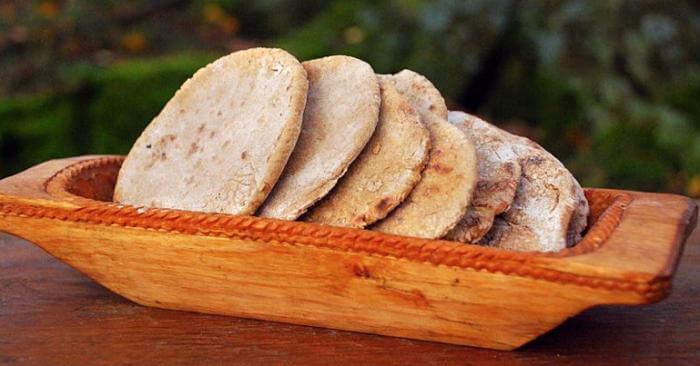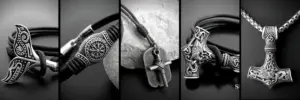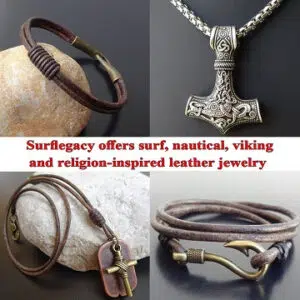These ancient inhabitants of Northern Europe which corresponds to the current Scandinavia and Denmark, are also famous for their strong body and their warrior connotation. The Vikings are remembered today as proud, warlike people known for their mythology and elaborate funerals.
Most people, however, are unfamiliar with the Viking diet. Hopefully, this article will help you to understand better these fascinating people and their diet.
Key Takeaways
- The Viking diet was based on what could be produced locally in their harsh climate. This included grains like barley, oats and rye, vegetables, fruit, dairy, meat from livestock, fish, and game.
- Bread was a dietary staple, often made with coarser grains than the wheat used in other parts of Europe. Porridge was also commonly eaten.
- Dairy foods like milk, cheese, skyr and whey provided important proteins and fats.
- Fish, caught locally in rivers, lakes and seas, also provided a lot of protein in the Viking diet.
- Meat from domesticated and hunted animals was eaten, with pork being particularly prized.
- Preservation techniques like salting, smoking and pickling allowed food to be stored for the winter months.
- The Viking diet provided high caloric intake and lots of protein, which likely contributed to their strength and stamina.
What did these warriors eat to survive in such a harsh environment?
They had to make do with what their territory offered, not much to tell the truth. However their food was healthy and fresh, and even a poor Viking ate much better than an English peasant during the Middle Ages.
That’s not to say the Viking diet was without flaws, but on the whole, it was a model of efficiency and innovation in a time when cooks had to make the most of very limited ingredients.
The climate was in fact too harsh to allow the growth of many species of vegetables and the snow, which for all the long winter months from October to February completely whitened the landscape, only worsened the situation. The possible crops were barley, oats and rye.
The activities the Vikings engaged in were farming, animal husbandry and fishing. Meat from livestock played an important role in the Viking diet and included beef, goat, pork, sheep, chicken and duck.
What they could not get from agriculture and from the animals they raised, they got from fishing and hunting. The Viking diet was hyperproteic, probably, this was the reason for the undisputed physical strength of the Norse warriors.
Being able to physically dominate the opponent gave them a distinct advantage in battle, allowing them to handle with ease and dexterity the weapons used. The fact that everyone in society, from kings to common sailors, ate meat every day was a major advantage of the Viking diet.
In what consisted, the typical Viking Diet?
This is a very frequently asked question by Viking fans and answering has not been an easy task for historians due to the almost total absence of written records. Nordic people, in fact, handed down their memories and traditions almost solely orally.
The Vikings obtained their food through farming, hunting, and fishing. Farming was the main source of food for the Vikings. They grew crops such as wheat, barley, and oats. They also raised livestock such as cattle, sheep, and pigs.
They used oats and barley to make flour, which was then made into a flatbread that was baked on a griddle. Some of the grain was also fermented and processed to make Viking beer.
Although small in size, the average farm was more than enough to provide enough food for the people who lived there, allowing them to be self-sufficient. In addition to this, the Norse grew a fair variety of vegetables, the contribution of which was of considerable importance in the preparation of true Viking food.
The Viking diet was, therefore, based on a great caloric intake (the average Viking consumed around 2,000 calories per day) derived from proteins. They also ate a lot of fish, including herring, mackerel, and cod, but meat and fish were not the only sources of food.
Many animals, in fact, were not bred only for the consumption of meat, but also for the additional resources they brought. Vikings drank a lot of milk and ate a lot of cheese. They milked their cows to satisfy the need for milk which was also used to produce cheese, skyr, curd, and butter. They also collected duck and chicken eggs, which were a constant element of their diet.
As already mentioned, they were skilled fishermen and hunters. They fished for whatever fish was available to them both in the ocean and in the rivers. Fishing was in fact such an important part of the Viking diet that it is estimated to represent 25% of their diet.
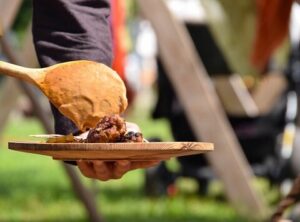
The cooking of the Vikings, therefore, had to adapt to the limited possibilities offered by nature. The greatest resource for their meals was represented by hunting and consequently, meat was one of the basic dishes of their gastronomy.
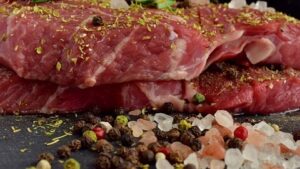
On their tables every day appeared different kinds of animals, roasted or smoked, but one of the most delicious dishes, to be reserved for special occasions, was snake in casserole, usually flavored with garlic and thyme. Even cheeses were very appreciated.
However, despite the Viking diet’s overall balance, there were some major pitfalls. Archeological excavations of Viking cesspits and sewers have revealed that most Vikings had parasites in their intestines: to put it bluntly, they had worms.
The same cesspit excavations turned up undigested seeds from the whole wheat breads Vikings ate, some of which came from highly poisonous weeds.
Popular Vikings Foods
Vikings were skilled homesteaders who thrived in harsh conditions. However, doing so required a significant amount of planning, work, and options.
Of course, things did not always go as planned. When the historical Floki first established a colony in Iceland, his people were so enthralled by the excellent fishing that they neglected to gather enough fodder for their animals. As a result, the colony died of starvation that winter. Later settlers, on the other hand, learned from their mistakes, and Iceland eventually thrived.
According to the sagas and archaeology, the most important food sources of the Viking diet are as follows
Bread and Porridge
It is not an exaggeration to say that bread is the foundation of European civilization. Bread is easy to make (with a little practice), versatile, shelf-stable, and high in calories.
However, much of the Viking homeland was cold and had poor soil. Denmark possessed land capable of producing high-quality wheat. However, the rest of Scandinavia was forced to rely on other grains such as barley, rye, or oats.
The typical bread of the day is described in Rigsthula (an Elder Edda poem) as “heavy and brown and stuffed with husks.” In the same poem, the wealthy are described as eating “slim and white” bread (probably made with imported wheat from trading).
So bread remained important to the Vikings, but perhaps less so than it was elsewhere in Europe, where everyone ate pounds of it every day.
When they didn’t have the time (or energy) to grind their grains into flour and let the yeast raise the dough, Vikings simply boiled their whole grains until they were soft enough to swallow.
This porridge was most likely not the sweet, wholesome oatmeal your grandmother used to make, but rather a mash-up of whatever herbs or flavorings were on hand.
The Vikings of Harald Hardrada’s court grumble in the Tale of Sarcastic Halli (Icelandic, 13th century) when they are served porridge instead of a feast. But, as Harald always says, “it’s the best of dishes with butter.”
Archaeologists have discovered teeth worn down from chewing these tough grains in the skeletal remains of even young Vikings.
Dairy Food
Dairy In the Viking Age, the heads of cattle family-owned and the bales of wool their farm produced were two of the most important measures of wealth. Cattle and sheep were both edible, but they were more valuable for the milk they produced.
Milk is a renewable resource, and the butter, cream, yogurt, and cheese made from it served as the Viking diet’s primary source of protein and fat. The Vikings, not ones to waste food, are mentioned in the sagas drinking whey, a protein-rich byproduct of cheese production.
Dairy products, along with fish, provided the majority of the Vikings’ daily essential nutritional needs.
As a result, it is not surprising that people from Scandinavia and the British Isles still have some of the best lactose tolerance in the world.
Fish
Almost all Vikings lived near rivers or coastlines. Vikings are always associated with their longships (and for good reason). Even so, simple dug-out canoes were some of the most common aquatic vessels during the Viking Age (Price, 2020). Almost every Viking family had one of these or similar small boats, and almost every Viking family fished.
The Vikings developed a variety of fishing techniques for all types of waters, whether at sea or along the coast. A line was used to catch large fish that could feed a family (such as salmon, halibut, striped bass, haddock, or cod).
Small fish, such as herring (which could be salted and stored for later use), were caught in nets. Fish provided protein, Omega-3 fatty acids, and essential nutrients.
Animals in the wild
Northern Europe in the Middle Ages was characterized by vast stretches of dense forests teeming with wildlife. Vikings took advantage of this by hunting deer, reindeer, elk, hare, and other large and small mammals.
Vikings were well-known fur trappers, and they may have consumed some of this prey as well. Vikings hunted wild fowl with bows, slings, nets, and falcons. In some cases, children can help their families by catching birds in nets.
As glamorous as it may appear, taking down game with short-range weapons takes time and requires skill and effort. Vikings had to weigh the benefits and drawbacks of abandoning their other tasks to pursue game in the dangerous forests.
It is also true that some of the places the Vikings called home, such as Iceland or the Scottish isles, did not exactly have forests teeming with deer. As a result, the idea that Vikings ate venison on a daily basis is most likely a myth. Game was more of a welcome addition to the diet than the diet itself.
Sea Animals
Seals, walruses, and aquatic birds have been discovered in Viking settlements, particularly in more remote locations such as Greenland, Iceland, and northern Scandinavia. Most Vikings probably used this as a supplement to their diet, but fur trappers in the far north likely relied on these food sources while they were out hunting.
Walrus ivory (tusks and teeth) was traded as far east as Iraq, and seal skins were used for ship rigging, so the meat of these animals was a bonus.
Vikings did not usually try to catch whales at sea, as northern Europeans did later. However, Vikings made extensive use of washed-up whales, eating their meat and using their bones and fat for a variety of other purposes. Feuds over the rights to beached whales are mentioned in sagas such as Njal’s Saga and the Vinland Sagas.
Domestic Animals
Cows, goats, sheep, pigs, and chickens were essential to Viking life because they provided dairy, eggs, and wool. Some animals, such as oxen, horses, or donkeys, were useful for labor or transportation. Domestic animals, however, were eaten as food, and not just during times of famine.
If a Viking ate his domestic animals faster than he could replace them, he would soon become bankrupt. Herd management and animal husbandry were therefore essential skills.
Furthermore, due to a lack of cold storage for food, a large animal had to be shared with a large number of people or it would go to waste. Food sharing was a way for friends and family to strengthen their bonds.
Sheep were one of the most important animals during the Viking Age because their wool was used for clothing and boat sails. They do not, however, live forever, and volcanic ash in places like Iceland has worn their teeth out prematurely.
Mutton was thus a popular dish among the Vikings. Due to the loss of wool production, lamb (which is much more flavorful and tender) was probably rarely eaten.
Beef was especially popular during feasts, it was also a favorite of specialized warriors like Housecarls (professional bodyguards for a lord) and Varangians. Throughout the Middle Ages and Renaissance, beef was associated with elite military forces.
Pork was the Vikings’ most celebrated meat. Every night in Valhalla, the Einherjar (Odin’s chosen slain) were said to feast on pork. Freyr and Freyja, the god and goddess of plenty and fertility, were associated with the pig and the boar. This association with good fortune and prosperity is one of the reasons that pork (particularly ham) is still served at feast days today.
Although it may be upsetting to some, Vikings did eat horses on occasion. Eating horses was forbidden in Christian countries during the Middle Ages, but the Vikings ate horses as part of religious rituals (now poorly understood).
Though horses were occasionally the steeds of gods and heroes, such as Odin’s Sleipnir and Sigurd’s Grani, most Vikings fought on foot and saw the horse as a mode of transportation. When Iceland became Christian in the year 1000, it was legally mandated that horse eating be permitted to continue.
Vegetables and fruits
Vegetables and fruits were far more untamed than any of our modern cultivations. Carrots would have been added to the daily skause, but they weren’t orange; the only carrots available were white. Viking farmers grew cabbages, beans, peas, carrots, leeks, turnips, parsnips, garlic, onions, and other root vegetables, and endive, and Middle Age diners could also enjoy wild apples and berries and nuts in season
How did Vikings cook their food?
Viking cooking was, by our standards, simple. The meat was stewed, boiled on the bone to make soup (and thus feed more people), or spit-roasted. According to the court records of Charlemagne (a contemporary of the Vikings), his physicians wanted the Emperor to eat his meat boiled rather than roasted as he preferred.
This could be because the higher cooking temperatures made parasites less likely to survive, or it could simply be another quirk of medieval doctors. Although archaeological studies in one Viking neighborhood in Britain discovered a high incidence of intestinal parasites, studies in other locations did not.
Baking was done over an open fire or in wood-fired ovens. The temperature of the loaves was determined by careful manipulation of the fire and placement of the loaves. To avoid bread that was burned on the bottom and raw in the middle, some knowledge was required. Ragnar’s men are so taken with Aslaug’s beauty in the Saga of Ragnar Lothbrok that they burn the crew’s breakfast bread.
The farm wife famously chastised King Alfred for burning the cakes (a type of quick bread, not like our cake today) while in deep cover hiding from Vikings. Herbs were used to flavor soups, stews, and porridges. This included “traditional” herbs such as rosemary, thyme, sage, dill, coriander, tarragon, and others.
It also included herbs that were less well-known, such as ramsons, nettles, angelica, mugwort, and woodruff. Vikings did not have access to hot spices, but they did have access to horseradish, which they may have used. The flavors of onions, leeks, and garlic were intense.
All Vikings had access to salt, whether through trade, discovery in the environment, or boiling down seawater. Pepper, on the other hand, was a hot commodity in Europe and was most likely unavailable to the Vikings.
Although some sagas mention Vikings adding honey to meats, little is known about Viking sauces (if there were any). Overall, Vikings ate food that was elegant in its simplicity, allowing the flavor of the natural product to take precedence over the cook’s inventiveness
What methods did they use to preserve food?
In the past, people used a variety of methods to preserve food. Some of the most common methods were pickling, salting, smoking, and drying. Pickling was a popular method of preserving food, especially vegetables. To pickle something, it was soaked in a vinegar or brine solution.
This helped to prevent spoilage and keep the food fresh for a longer period of time. Salting was another common method of preserving food.
For these purposes, archaeologists have discovered Viking Age smokehouses and storage sheds. Cooked meat could also be stored in vats of whey for a short time because the acidity of the whey would slow spoilage. These whey vats are mentioned in the sagas, with one Viking hero using one to escape his hall burning.

Remnants of a Viking cooking pot by Thomas Quine
Royal Ontario Museum, Toronto, Canada, 2017
Viking Meals
The first meal of the day, “dagmál” or “meal of the day”, was very large and was usually eaten one or two hours after the start of the daily tasks. For the dagmál, adults used to eat a portion of leftover stew from the previous night’s meal. In addition to this, they also usually ate some bread and fruit where available.
The second and final Viking meal of the day was known as the “náttmál”, or “night meal”. This was served at the end of the working day, usually around 7 and 8 pm, and served as dinner. Women, assigned to the kitchen, were in charge of the preparation of the recipes. The evening meal usually consisted of a fish or meat stew cooked with vegetables.
The stew was accompanied by bread and, occasionally, fruits or nuts sweetened with honey, the only sweetener at their disposal
The “cutlery” of Vikings consisted of wooden bowls and knives, forks and spoons.
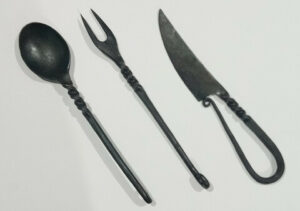
Drinks, especially beer and mead, were served inside ox horns; the custom was to drink all the contents in one big gulp, so that the horn could be placed on the table again only when it was completely empty. In practice, an invitation to go on a binge, which was not at all rare during the Vikings’ lunches.
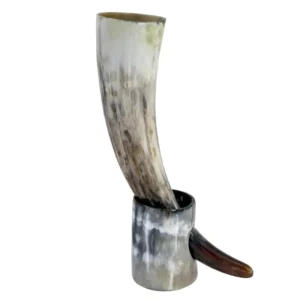
Viking Beer
The Vikings also produced excellent beer, which was an important part of their Viking diet. Recently some historians have found traces of burnt barley in the Viking camps of Greenland and it seems certain that they were able to produce excellent beer during their oceanic crossings.
This beverage also had an important role in rituals and religion and, for example, it was drunk on the seventh day after the death of a dear extinct as a commemoration. According to Viking beliefs, the bravest warriors received cups full of beer at their arrival in paradise (Valhalla) thanks to the generosity of ‘Heidrunn’, a giant goat that instead of producing milk produced beer. Moreover, Vikings believed that during the fermentation process this beverage released a vital energy propitiatory to war.
How did the viking diet compare to other contemporary diets?
The Viking diet was surprisingly similar to other contemporary diets of the time. They ate a lot of meat, fish, and vegetables, with very little dairy or grain. This was probably due to the fact that they were constantly on the move and didn’t have time to cultivate crops. They also didn’t have access to many of the same spices and flavoring agents that we have today, so their food was probably pretty bland by today’s standards.
What can we learn from the Viking diet today?
We can learn a lot about nutrition and healthy eating from the Viking diet. Their diet was based on fresh, local ingredients that were either grown or hunted. Meat was a big part of the diet, as were vegetables, fruits, and dairy. It was also very high in protein and fat, which is why Vikings were known for their strength and stamina.
Viking Diet FAQs
What did Vikings typically eat in a day?
Vikings usually ate two meals a day. The first large meal called “dagmal” featured stews, bread, porridge, and leftovers. The second smaller “nattmal” meal in the evening consisted of meat or fish stew with vegetables.
What kind of meat did Vikings eat?
Vikings ate beef, mutton, pork and goat meat, as well as poultry like duck and chicken. Pork was especially prized. They supplemented with wild game like deer when available.
Did Vikings eat a lot of fish?
Yes, fish was a major part of the Viking diet. They heavily relied on local fishing and consumed species like herring, cod, salmon and halibut.
What vegetables and fruits were available to Vikings?
Vikings grew and gathered wild cabbage, beans, roots like carrots and parsnips, onions, leeks, nuts, apples and berries in season. Their vegetables were less domesticated than modern varieties.
How did Vikings preserve foods?
Vikings used pickling, salting, smoking and drying to preserve foods and make them last through the winter months. They also stored cooked meats in whey.
Final Thoughts
In this article, we have widely discussed what their diet was, what they drank, how they produced their food, and how Viking nutrition contributed to their success.
It emerges a different portrait from that usually reported, that of violent people inclined to war. On the other hand, the Vikings also had to cook, sow the fields and dedicate themselves to breeding, just like all the other populations.
Are you passionate about Viking Culture or Norse Mythology?
Surflegacy is the final destination for the modern Viking/ Norse Mythology fan looking for cool Viking necklaces & bracelets. For more Viking Jewelry, do not hesitate to visit our store

